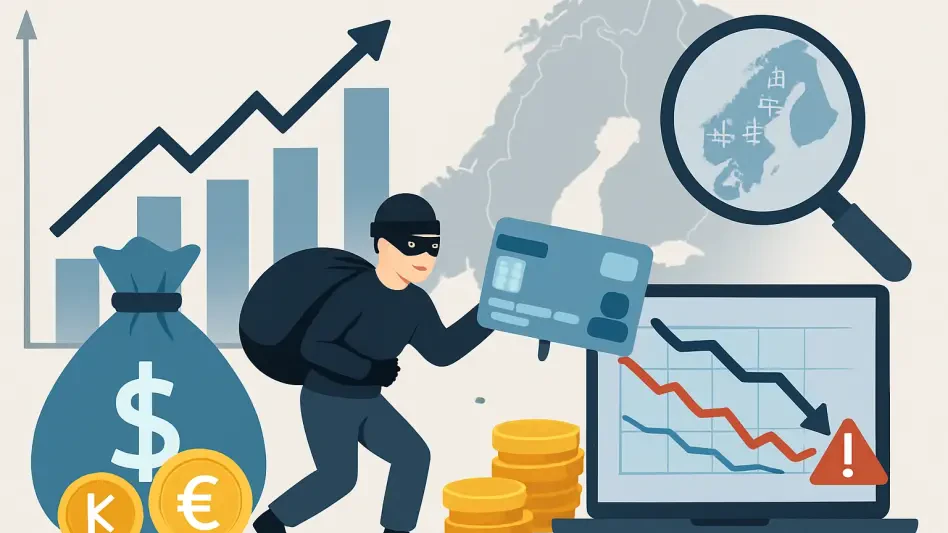In the ever-evolving landscape of financial security, the Nordic region presents a fascinating case study of contrasting challenges and responses to fraud, with recent data highlighting significant differences between Sweden and Norway. A comprehensive survey conducted by YouGov for Tietoevry Banking, involving over 1,000 respondents from each country, reveals striking disparities in the experiences of financial fraud and identity theft between the two nations. While one nation grapples with a rising tide of reported incidents, the other shows signs of improvement, yet both face persistent threats from increasingly sophisticated criminal tactics. This divergence raises critical questions about the effectiveness of preventive measures, the role of technology such as artificial intelligence (AI), and the shifting public perceptions that shape trust in financial systems. As cybercriminals adapt and innovate, understanding these regional disparities becomes essential for developing targeted strategies to protect consumers and maintain confidence in digital transactions across the Nordics.
Contrasting Experiences of Fraud Exposure
The survey results paint a clear picture of diverging trends in fraud exposure between the two neighboring countries. In Sweden, a concerning 16% of respondents reported that they or a family member had been victims of financial fraud or identity theft within the past year, marking the highest level recorded since tracking began. This upward trajectory suggests that Swedish consumers are increasingly vulnerable, potentially due to gaps in awareness or the rapid adoption of digital payment systems that outpace security measures. The data reflects a growing challenge for authorities and financial institutions to curb this trend before it escalates further, as each incident erodes trust in the safety of online transactions and personal data protection. Beyond the numbers, the emotional and financial toll on victims underscores the urgency of addressing this issue with robust, proactive interventions that can keep pace with criminal ingenuity.
Meanwhile, Norway presents a more optimistic outlook, though the threat remains far from negligible. Only 12% of respondents reported similar experiences of fraud, a notable decline from a peak in previous data. This reduction might indicate the effectiveness of recent preventive initiatives or heightened public awareness campaigns that have encouraged safer online behaviors. However, experts at Tietoevry Banking caution against complacency, noting that their systems still detect a high volume of fraud attempts daily. Criminals are employing advanced methods, including AI-driven schemes, to target unsuspecting individuals. This suggests that while fewer Norwegians may be falling victim, the underlying risk persists at a significant level, requiring continuous vigilance and investment in cutting-edge defenses to maintain this downward trend and prevent a resurgence of successful attacks.
Escalating Scale of Fraud Attempts
Behind the scenes, the scale of fraudulent activity targeting Nordic consumers is staggering, even if many attempts are intercepted before causing harm. Tietoevry Banking’s monitoring data reveals that in the first half of the current year, the company, alongside partner banks, blocked fraudulent payments amounting to NOK 2.3 billion directed to illegitimate online merchants. This figure represents a dramatic 60% increase compared to the same period last year, highlighting the relentless efforts of cybercriminals to exploit vulnerabilities in financial systems. Such a sharp rise indicates that while reported victimhood may differ between Sweden and Norway, the potential for widespread damage remains alarmingly high. The success of these preventive systems in thwarting attacks demonstrates their critical importance, yet it also serves as a stark reminder of the resources and sophistication criminals are willing to deploy.
This escalating threat is compounded by the innovative tactics employed by fraudsters, which often outpace traditional security measures. The use of AI to generate convincing phishing schemes, deepfake identities, and automated fraud attempts has become a growing concern, as these tools enable criminals to scale their operations with unprecedented efficiency. For financial institutions, staying ahead requires not only technological advancements but also collaboration across borders and sectors to share intelligence and best practices. The sheer volume of blocked transactions underscores that the battle against fraud is far from won, even in a region known for its advanced digital infrastructure. As criminals refine their approaches, the pressure mounts on banks and regulators to fortify defenses and ensure that consumers are not left bearing the brunt of these sophisticated attacks.
Public Trust and Technology Concerns
Public perception of fraud prevention measures offers another layer of complexity to this issue, as trust in both institutions and technology appears to be waning. In both Sweden and Norway, survey respondents expressed a declining willingness to share personal financial information for fraud prevention purposes, reflecting heightened skepticism about data security practices. This reluctance poses a significant barrier to implementing effective monitoring systems that rely on such data to detect and prevent fraudulent activity. The erosion of trust may stem from high-profile data breaches or a general unease about how personal information is handled in an increasingly digital world, making it imperative for financial entities to prioritize transparency and robust privacy protections to rebuild confidence.
Compounding this issue is the ambivalent attitude toward emerging technologies like AI, which are viewed as both a potential safeguard and a threat. Nearly half of Swedes and over 40% of Norwegians expressed concern that such tools could increase their risk of fraud due to misuse by criminals, a marked shift from more optimistic views in prior surveys. This duality highlights a broader unease about the rapid integration of advanced systems into financial ecosystems, where the benefits of automation and enhanced detection are weighed against the fear of exploitation. Addressing these concerns requires not only technological innovation but also clear communication to educate the public about how AI can be harnessed responsibly to enhance security, while simultaneously strengthening regulations to prevent its abuse by malicious actors.
Navigating Future Challenges in Fraud Prevention
Reflecting on the insights gathered, it becomes evident that financial fraud and identity theft pose persistent challenges across the Nordic region, despite the varying trends observed. The rise in reported incidents in Sweden contrasts sharply with Norway’s decline, yet the underlying threat remains consistent, as demonstrated by the massive volume of blocked transactions. Criminal sophistication, particularly through AI, has added layers of difficulty to prevention efforts, while public skepticism about data sharing and technology has further complicated the landscape. Tietoevry Banking’s interventions have proven vital in curbing potential losses, underscoring the value of proactive measures in this ongoing battle.
Looking ahead, the focus must shift toward actionable strategies that address both the technological and human elements of fraud prevention. Financial institutions should invest in next-generation security systems while fostering international collaboration to counter cross-border threats. Equally important is rebuilding public trust through transparent policies and educational initiatives that demystify the role of tools like AI in safeguarding transactions. By aligning innovation with consumer confidence, the Nordic region can set a global standard for combating fraud, ensuring that criminals find no fertile ground for their schemes in the years to come.








